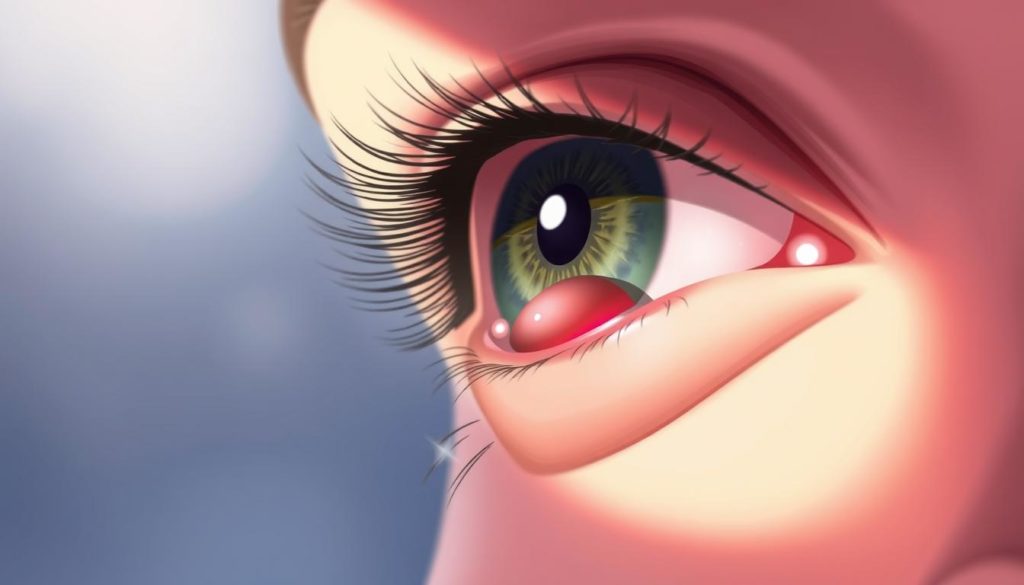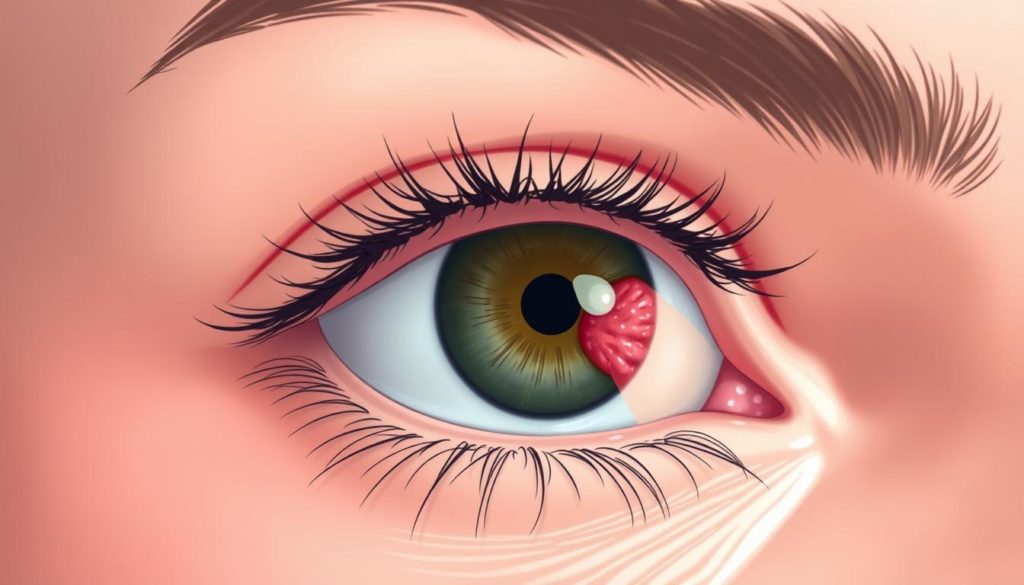Did you know around 30% of adults will get a stye at some point? This fact shows how common styes are and highlights why knowing about their treatment and prevention is crucial. Styes are caused by inflamed oil glands and can bring a lot of discomfort.
Learning about what causes styes can help you avoid them and treat them well. While home remedies can provide some relief, it’s best to see a doctor for a proper diagnosis and treatment. This article will explore the causes, symptoms, and treatments for styes, helping you manage and prevent them.
What Is a Stye?
A stye, also known as a hordeolum, is an inflamed oil gland on the eyelid. It looks like a red, painful lump near the edge of the eyelid. Knowing about styes is helpful for treating and preventing them.

Definition and Overview
Styes come from a bacterial infection. They’re often caused by Staphylococcus bacteria. These bacteria make the oil glands in the eyelids swell, turn red, and hurt. Though they may look scary, styes usually get better with simple home care and rarely need a doctor’s help.
Common Misconceptions
Some think styes are contagious. This isn’t true; they don’t spread from person to person. Another myth is that poor hygiene causes styes. Good hygiene helps prevent them, but styes can still happen even if you’re clean. Understanding these facts can help you treat styes the right way.
Stye vs. Chalazion
Many people wonder about the difference between a stye and a chalazion. They both impact the eyelid, but they’re not the same:
- Stye: This is a bacterial infection of the oil gland, causing a painful, red lump.
- Chalazion: This is a blocked oil gland without infection, resulting in a painless, firm lump.
Understanding these differences is important. It helps in getting the right treatment and managing each condition properly. Knowing the difference between a stye and a chalazion can ease your worries and lead to better care.
Common Stye Symptoms
Knowing about stye symptoms is key to manage this eye problem well. Spotting them early and starting treatment can stop them from getting worse.
Early Signs
At first, you might notice your eyelid feels sore, looks red, and has a small bump. Though easy to miss, catching these early signs is important for quick treatment.
Progressive Symptoms
The stye will then get more obvious. You’ll see your eyelid swell, feel more pain, and maybe see some goo. This is when it’s clear you need to treat the stye fast.

When to See a Doctor
If the stye doesn’t get better or messes with your sight, you need a doctor’s help. Sticking around or causing vision trouble means it could be getting serious, needing expert care.
| Symptom Stage | Common Symptoms | Action Required |
|---|---|---|
| Early Signs | Tenderness, Redness, Small Bump | Monitor and start basic stye treatment |
| Progressive Symptoms | Swelling, Pain, Discharge | Intensify stye treatment efforts |
| Severe Symptoms | Persistent symptoms, Impact on Vision | Seek medical advice immediately |
Stye Causes
First, let’s dive into what is a stye. It begins when certain bacteria, mainly Staphylococcus aureus, enter the oil glands on your eyelid edge. Knowing stye causes is the first step to prevent this annoying eye issue.
Several things can lead to a stye. These include:
- Poor eyelid hygiene
- Stress
- Hormonal changes
To avoid styes, living healthy and keeping eyelids clean are crucial. Always have clean hands, don’t touch your eyes, and keep stress in check.
Different Types of Styes
Learning about the different types of styes is important. It lets you spot the stye on eyelid and get the right help. External and internal styes look different and are found in different spots, but they come from similar stye causes.
External Stye
An external stye grows at the eyelash base, causing a painful bump. It’s easy to see and might leak or form a crust.
Internal Stye
On the other hand, an internal stye hides inside the eyelid. It’s harder to see but still hurts a lot. It comes from infected oil glands and dealing with it can vary.
| Feature | External Stye | Internal Stye |
|---|---|---|
| Location | Base of the eyelash follicle | Within the eyelid |
| Visibility | Highly visible | Less visible |
| Discomfort Level | Moderate to high | Moderate to high |
| Main Causes | Infected eyelash follicle | Infected oil gland |
| Treatment Approach | Warm compress and hygiene | Medical consultation may be required |
How to Get Rid of a Stye
Having a stye can be very uncomfortable. If it’s on your eyelid, you’ll want to take care of it quickly. Doing so helps ease the pain and stops more problems from happening. We’ll look at ways to treat a stye well.
Medical Treatments
If your stye is bad, you might need medical help. Doctors can give antibiotics as creams or pills to fight the infection. Sometimes, they might need to do a small surgery to drain the stye. Make sure to see a doctor to find the best treatment for your stye.
Over-the-Counter Solutions
For those wondering how to get rid of a stye, store-bought treatments can help. Taking painkillers like ibuprofen or acetaminophen can lower discomfort. Antibacterial creams from the store can also help fight the infection and heal faster. Just remember to carefully read and follow the instructions to avoid side effects.
Effective Stye Treatment Options
Choosing the right stye treatment is key when you have a stye. Spotting it early and acting fast makes a big difference. You’ll want to lessen swelling, ease the pain, and get rid of any infection.
| Treatment Method | Action | Recommended For |
|---|---|---|
| Warm Compress | Helps to reduce inflammation and promote drainage | Mild to moderate styes |
| Antibiotic Ointments | Targets bacterial infection directly at the site | Persistent or severe styes |
| Pain Relievers | Manages pain and discomfort effectively | All stages to alleviate pain |
| Incision and Drainage | Surgical procedure to remove pus | Severe or recurrent styes |
Knowing how to get rid of a stye matters. It depends on using the right treatments for how bad it is. It helps to look at these methods to find relief fast. Always talk to a doctor before trying new treatments to make sure they’re safe and right for you.
Stye Home Remedies
When you have a stye, home remedies can really help. They lessen discomfort and speed up healing. We’ll look at some easy but effective ways to treat a stye.
Warm Compress
Using a warm compress is a top remedy. Put a warm cloth on the affected eye for 10-15 minutes a few times a day. This helps the stye drain and reduces swelling.
The heat loosens the stye, helping the blocked oil gland open and let out buildup.
Proper Eyelid Hygiene
Keeping your eyelid clean is key for stye treatment. Gently wash the area with mild baby shampoo or saline solution. This helps keep bacteria away and prevents more infections.
Staying clean also helps stop styes before they start.
Avoiding Irritants
While treating a stye, avoid irritants. Don’t use makeup, contact lenses, and other items that could bother your eye. Avoiding these helps your stye heal quicker and prevents making it worse.
Stye Prevention Tips
Stopping a stye before it starts is easy with the right habits. So, here’s how to keep your eyes stye-free:
- Regularly wash your hands and face to cut down on bacteria. Keeping clean is key since bacteria mainly cause styes.
- Throw away old eye makeup. Outdated makeup can be full of bacteria, which might lead to styes.
- Don’t share towels or makeup tools. When you share them, you also share bacteria, raising your stye risk.
| Tip | Benefit |
|---|---|
| Maintain proper eyelid hygiene | Lessens chances of bacteria gathering |
| Use hypoallergenic makeup products | Helps avoid irritation and allergies |
| Avoid touching your face with unwashed hands | Stops oil and bacteria from spreading |
Making these stye prevention steps part of your daily life can greatly lower your chances of getting a stye. And that leads to healthier, happier eyes.
When Should You Seek Professional Help?
If your stye symptoms last even after trying home treatments, it’s time to see a doctor. Sometimes, styes that don’t improve with home care show there’s a bigger problem. If you have styes often or they affect your sight, get help right away.
Signs like ongoing pain, redness, and swelling mean you might need medical help. These symptoms suggest the problem is more serious than just a surface infection. If you ignore these signs, things could get worse. That’s why seeing a doctor is important.
An eye doctor, or ophthalmologist, can give you the right treatment for styes. They can offer specific treatments and maybe prescribe medicine. Getting help early can really help in controlling your stye symptoms and stopping new ones from forming.
FAQ
What causes a stye?
Styes happen when bacteria enters our eyelids. Stress, changes in hormones, and not cleaning your eyelids well can increase your risk.
What is a stye?
A stye is a painful, red lump on the eyelid. It’s caused by an inflamed oil gland. Styes can be on the outside or inside of your eyelid.
How can I prevent styes?
Keep your hands and face clean to stop bacteria spread. Throw away old eye makeup. Don’t share towels or makeup tools. These steps help prevent styes.
What are the symptoms of a stye?
Styes start as tenderness, redness, and a little bump. Later, they can swell, hurt more, and leak pus.
How do you get rid of a stye?
For a stye, doctors might suggest antibiotics or minor surgery. You can also use pain relievers and antibacterial cream from the store. Always talk to a doctor before trying new treatments.
What’s the difference between a stye and a chalazion?
A stye is from a bacterial infection in an oil gland. A chalazion happens when an oil gland gets blocked. They look alike but need different treatments.
Are there home remedies for treating a stye?
Yes. Warm compresses can help a stye drain and feel better. Keep your eyelids clean and avoid makeup and contacts to speed up healing.
When should I see a doctor for a stye?
If a stye doesn’t go away, hurts, or messes with your sight, see a doctor. Lasting pain, redness, and swelling need a doctor’s care.
What are the different types of styes?
External styes are near the eyelash base and easy to see. Internal styes are inside the eyelid and harder to spot. Both can hurt and need treating differently.
What are some effective treatment options for styes?
Treatment depends on the stye’s type and how bad it is. Warm compresses, store-bought products, and medical care like antibiotics or surgery can help. Start treatments early for the best chance of healing.


